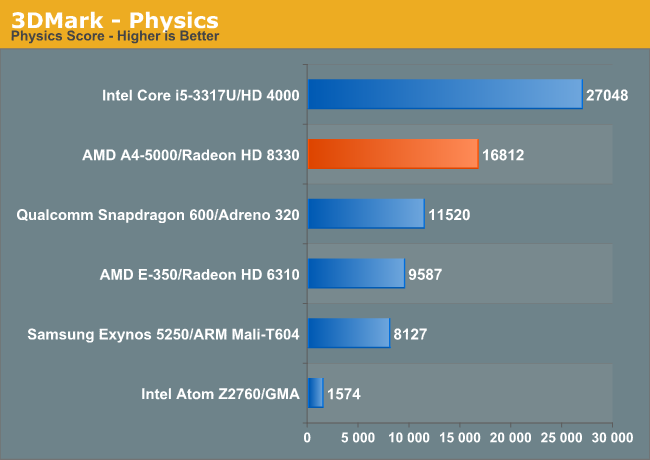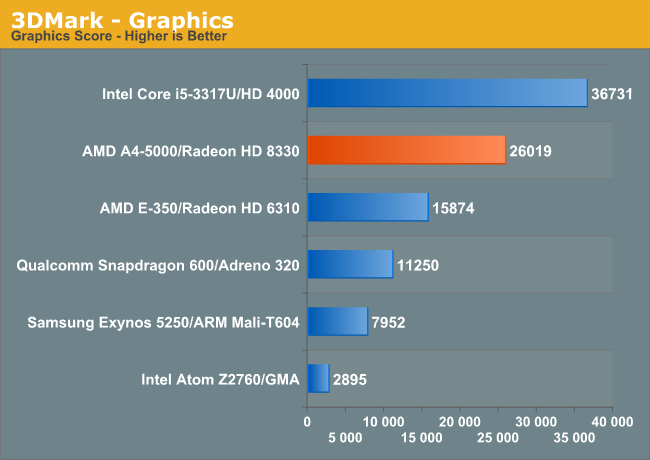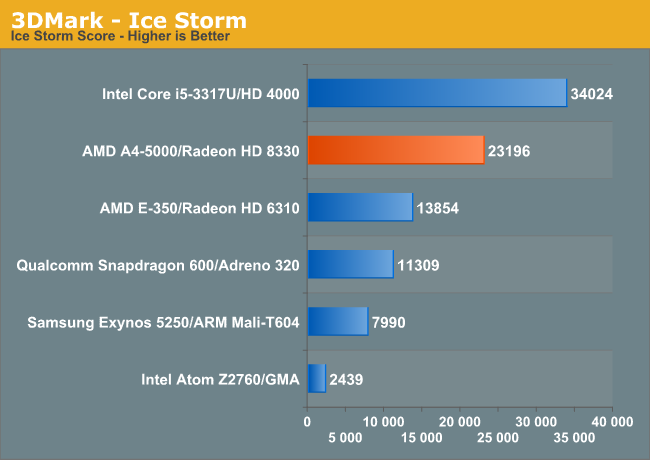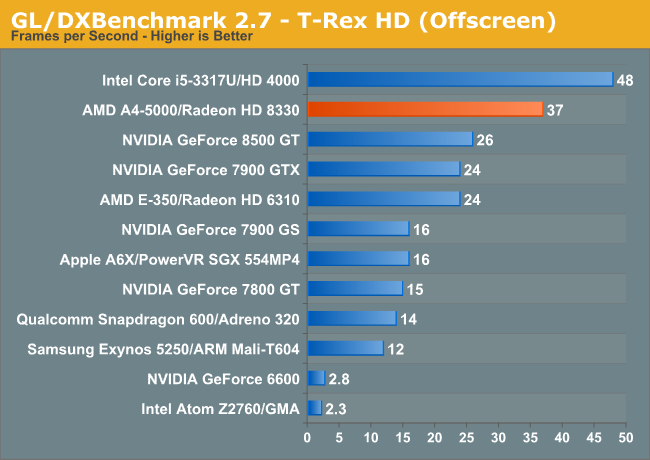The AMD Kabini Review: A4-5000 APU Tested
by Jarred Walton on May 23, 2013 12:00 AM ESTKabini vs CT/ARM: GPU Performance
I pulled out 3DMark and GFXBenchmark (formerly GL/DXBenchmark) for some cross platform GPU comparisons. We'll start with 3DMark Ice Storm and its CPU bound multithreaded physics benchmark:

The physics test is a bit unreasonably multithreaded, which is why we see a 75% uplift compared to AMD's E-350. For FP heavy game physics workloads however, Jaguar does quite well. While a big Ivy Bridge is still going to be quicker, AMD's A4-5000 gets surprisingly close given its much lower cost.
The 3DMark graphics test is more of what we're interested in seeing here. Two GCN compute units (128 SPs/cores) running at 500MHz will really put the old Radeon HD 6310 in Brazos to shame:

The results are quite good. Kabini manages a 61% performance advantage over AMD's old Brazos platform, and actually gets surprisingly close to Intel's HD 4000 in performance. As we discovered earlier, this isn't really enough performance to play modern PC games but casual (and especially tablet) gaming workloads should do wonderfully here.

The overall Ice Storm score just incorporates both physics and graphics test components. As expected, Kabini continues to lead over everything other than the i5-3317U.
Finally we have the GFXBenchmark T-Rex HD test. I threw in a handful of older PC GPUs, although keep in mind that T-Rex HD isn't very memory bandwidth intensive (penalizing some of the old big PC GPUs that had good amounts of memory bandwidth). The test is also better optimized for unified shader architectures, which helps explain the 8500 GT's excellent performance here.

Kabini does very well in this test as well. If we look at the tablet-oriented Temash part (A4-1200) we see that the number of GCN compute units remains unchanged, but max GPU frequency drops to 225MHz from 500MHz. If we assume perfect scaling with GPU clock speed, Temash could offer roughly the same graphics performance as the 4th generation iPad. AMD claims the A4-1200 Temash APU carries a TDP of only 3.9W, a potentially very interesting part from a GPU perspective if our napkin math holds true.
OpenCL Performance
For our last comparison we're looking at the OpenCL performance of these on-die GPUs. We're using a subset of Ryan's GPU Compute workload, partially because many of those tests don't work properly on Kabini yet and also because some of those tests are really built for much more powerful GPUs. We've got LuxMark 2.0 and two CLBenchmark 1.1.3 tests here. Their descriptions follow:
SmallLuxGPU is an OpenCL accelerated ray tracer that is part of the larger LuxRender suite. Ray tracing has become a stronghold for GPUs in recent years as ray tracing maps well to GPU pipelines, allowing artists to render scenes much more quickly than with CPUs alone.
CLBenchmark contains a number of subtests; we’re focusing on the most practical of them, the computer vision test and the fluid simulation test. The former being a useful proxy for computer imaging tasks where systems are required to parse images and identify features (e.g. humans), while fluid simulations are common in professional graphics work and games alike.
| OpenCL GPU Performance | ||||||||||||||||
| LuxMark 2.0 | CLBenchmark—Vision | CLBenchmark—Fluid | ||||||||||||||
| AMD A5-5000 (Radeon HD 8330) | 18K samples/s | 1041 | 1496 | |||||||||||||
| AMD E-350 (Radeon HD 6310) | 23K samples/s | 292 | 505 | |||||||||||||
| Intel Core i5-3317U (HD 4000) | 107K samples/s | 819 | 1383 | |||||||||||||
LuxMark is really a corner case here where Kabini shows a performance regression compared to Brazos. The explanation is simple: some workloads are better suited to AMD's older VLIW GPU architectures. GCN is a scalar architecture that is usually going to net more efficient usage, but every now and then you'll see a slight regression. Intel's HD 4000 actually does amazingly well in the LuxMark 2.0 benchmark.
Our two CLBenchmark tests however paint a very different picture. Here Kabini not only significantly outperforms its predecessor, but is faster than Ivy Bridge as well.










130 Comments
View All Comments
Gaugamela - Friday, May 24, 2013 - link
I'll beg to disagree with that. As a non-promotional price, for a notebook with a 1080p touchscreen display I think that 500$ is more than fair. As for promotions happening your line of reasoning seems to assume that discounts will only affect Intel notebooks which isn't clearly the case.While you may get cheap Ivy Bridge notebooks when in promotion, go search for cheap Trinity/brazos notebooks with promotions and you'll find them even cheaper. The same will be said of Temash/Kabini notebooks.
I fail to understand why you don't seem to acknowledge that.
Or the proposition of an APU that beats Pentiums and Celerons in performance (excluding single-thread performance, which is much less relevant nowadays) and has superior battery life.
Will Atom and Haswell Pentiums offer better performance/efficiency/price ratio? It remains to be seen.
whyso - Friday, May 24, 2013 - link
Depends really. With a 1080p screen its a good price. Sales happen all the time. Yes you can and will get i3 ULV systems for cheap and can get kabini systems for cheap. I'm simply saying given the fact that these promotion happen all the time literally (go to newegg laptops, sort by price-lowest and more than 75% of the notebooks on that page are on sale) you have to take these things into consideration. Kabini is competing against discounted but perfectly fine notebooks in this segment. You can get a nice lenovo g580 with SV i3 for $350. Any promotion that runs with a kabini notebook will have to match that price/perf and kabini is much weaker than SV i3.http://www.newegg.com/Product/Product.aspx?Item=N8...
whyso - Friday, May 24, 2013 - link
Sale % was taken from .ca g580 price from .com for .ca about half are on sale.dusk007 - Thursday, May 23, 2013 - link
The performance quite poor and notebookcheck doesn't really tell a different story. An i5 is the right CPU to compare it too because it runs in the same performance envelope. With all the other stuff that goes into a decent notebook or tablet/hybrid the CPU cost alone does make that much of a difference.The problem with Kabini is Single Threaded performance which matters for responsivness in plain old office work loads. Which is what most of these notebooks do. x264, cinebench, ... none of that really matters.
And gaming. In game low settings don't do much for CPU requirements and that is why even at low many games aren't playable. Something Intel can offer despite its HD 4000 which has nowhere near the reputation of AMD's GCN. If all you want is an office notebook for some casual gaming like a bit of Starcraft. An i5 is still a worthwhile investment.
Gaugamela - Thursday, May 23, 2013 - link
The i5 is the right CPU because it runs in the same performance envelope??????? How about no??How much more does the i5 cost?
andrewaggb - Thursday, May 23, 2013 - link
Well theres two arguements. One is cost, and yes amd will come in cheaper because intel likes their margins. So if cost is your primary motivator than this chip looks good.The other argument is performance/watt and peak performance, both of which make an i5 look much better than this chip.
Now it's true an i5 doesn't scale down to 3.9W, so in that market this chip appears to be a real contender and the one to beat. But that's not the version that was tested here today so we don't know that for sure.
Personally, I'm disappointed, and think haswell will compare very favorably in all metrics except price. I'm not sure haswell will be tablet suitable though, where some sku's of this chip should be.
Not saying this chip is terrible, just saying for anything 8-9W and up it seems to me haswell will be the clear choice if price isn't a major factor.
Gaugamela - Friday, May 24, 2013 - link
And this is a product that competes on price and battery life. Not performance as Haswell does.dusk007 - Saturday, May 25, 2013 - link
Just that it does compete on performance doesn't mean performance isn't valuable information. How much speed loss are you dealing with when going with cost effectiveness. This isn't a smartphone CPU that will ultimately end up running different software. It is still Windows and the same games and programs as an i5 is used for.The cost difference in the end product isn't that huge or insurmountable. The buyer would like to know how much they get when paying up or who much they loose when going cheap. Comparing it only with Atoms would be cheating and something marketing folks do not a review site that wants to have some reputation.
These chips don't go into Smartphones not even Tablets (that is Temash) they go where 15W Haswells will go and 2/3 of those sub $800 notebooks BOM is still none CPU related. So even if Kabini was given away for free the notebooks would still cost something.
Parhel - Friday, May 24, 2013 - link
But price is always a major factor. It's the "majorest" factor. This is a site for enthusiasts (read geeks) but think of the person at the AT&T store who picks the 2 or 3 generation old iPhone because it's $50 cheaper.tunaman - Thursday, May 23, 2013 - link
AMD set the standard with x64 that Intel evetually agreed was superior and joined. With the introduction of these hUMA (fully shared CPU and GPU memory) chips AMD has again set the standard that Intel will have to copy.As I've said before; Intel hasn't been a tech leader in a decade and, again, they'll be playing catch up once they cave to AMD's superior design. But by then, just as has been true for years, Intel graphics and multitasking will continue to lag behind AMD. Intel's only bragging right is saving one or two watts and slapping an "Intel Inside" tatoo on products, but charging twice as much for it. http://goo.gl/OItwV